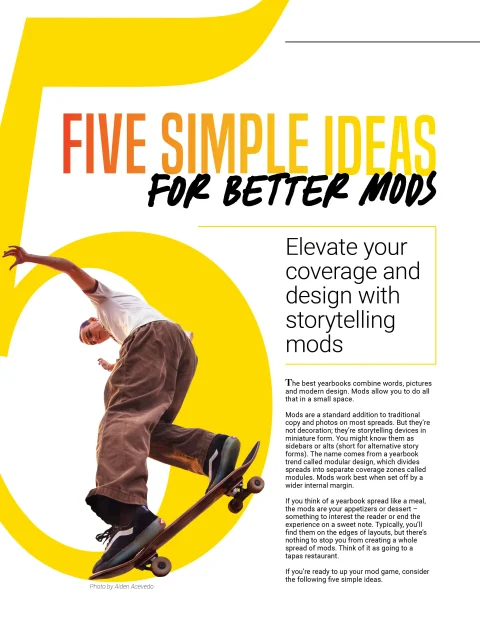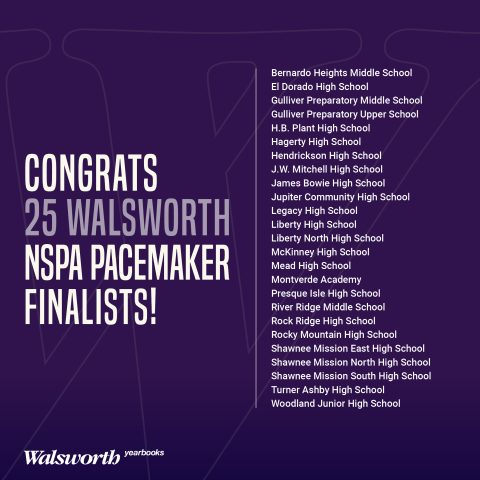The best yearbooks combine words, pictures and modern design. Mods allow you to do all that in a small space.
Mods are a standard addition to traditional copy and photos on most spreads. But they’re not decoration; they’re storytelling devices in miniature form. You might know them as sidebars or alts (short for alternative story forms). The name comes from a yearbook trend called modular design, which divides spreads into separate coverage zones called modules. Mods work best when set off by a wider internal margin.
If you think of a yearbook spread like a meal, the mods are your appetizers or dessert – something to interest the reader or end the experience on a sweet note. Typically, you’ll find them on the edges of layouts, but there’s nothing to stop you from creating a whole spread of mods. Think of it as going to a tapas restaurant.
If you’re ready to up your mod game, consider the following five simple ideas.
-
Mods can be anything
Your imagination is the limit when it comes to creating a mod. Consider a timeline, Q&A, quote collection, poll or profile. The 2026 Walsworth Planning Kit includes a poster called “Master the Mod,” full of mod ideas for inspiration. My students created an all-mod spread about a new building
on our campus.
They included the following approaches:
- A numbered list of fast facts
- Students’ favorite spots in the new building
- A Q&A with an administrator
- A poll about the new student crosswalk
- The distance between the new and old buildings
- A comparison of a tall sophomore and a shorter freshman’s number of steps
Typically, mods include a visual, text, a headline and a source, but none of those are required. In the 2024 Lone Star, the James Bowie High School staff in Austin, Texas, created monthly calendars using stylized text.
-
A little goes a long way
Think of it as more ideas, less ink. Mods should be compact, especially when featured on a spread with a traditional story, photos and captions. Bite-sized but full of information. You want them to be an entry point for readers without overwhelming the rest of the content. Space elements tightly – text wrap is your friend – and say what you want to say succinctly.
One of my favorite mods from our 2025 book is simply a photo of two soccer players walking away from the camera with their arms around each other, accompanied by a quote from one of the athletes about her senior year. The words and picture speak for themselves; they don’t need an unnecessarily sentimental narrative that might sneak into a full-blown article.
-
Even in a small space, remember good design and photography
Remember to apply your design principles: contrast, repetition, alignment and proximity.
- Contrast: Make sure your mod has a clear dominant element. If your spread has multiple mods, vary the headline size to contrast between the two and create a hierarchy.
- Repetition: Practice consistency when formatting elements within your mod and from mod to mod. If your mod is a quote collection accompanied by images, apply the same photo and text treatments for each person featured. You can even use the same mod template as a recurring element to further tie your book together.
- Alignment: Line up item edges to keep your design crisp. Be consistent with your mod’s internal and external margins.
- Proximity: You’re trying to use space as efficiently as possible. Pack elements tight, keep them readable and use placement to emphasize the relationship between mod elements.
When it comes to photography, don’t slack off – even if you’re only using headshots. Make sure each person is well-lit and avoid shadows on faces. You may need to spend time editing your photos before placing them, but the difference it makes is well worth it. Keep the background simple; it will be easier to cut out and less distracting than if left in. If you leave it in, move your subject away from the wall to give the photo a little more depth. When taking the picture, be consistent with how you frame the individual so you don’t accidentally cut off part of a person’s shoulder. Take full-body shots you can crop down later for the most versatility.
-
Use mods to expand your coverage
Mods are a great way to fit more people on a spread, so feature students who aren’t already on the spread. Because mods don’t have to rely on candid action shots, you can include students you may have missed when covering an event. That soccer player who rides the bench? Mods offer a way to tell their story. That community service club event you couldn’t make it to? Pair club members’ selfies from that day with their quotes to capture what happened. That photo of the hilarious thing that happened at the pep rally? Get the reactions of people who aren’t in the picture.
Include quotes in your mods whenever possible. For example, if you create a mod about favorite cafeteria meals, don’t just list meatloaf or chicken tenders. Have students explain what they like in their own words. In our mod about first-day outfits, students didn’t just show the clothes; they included the story behind what people wore.
-
Emphasize your theme through your mods
With every spread covering something different, mods provide a great way to unite the book. Incorporate your theme’s design elements and spin-off phrases. Sometimes, the same word over and over again in primary headlines can get heavy-handed. But when you do the same thing with mod headlines, it’s more of a gentle nudge. You might even have mods you repeat throughout the book where you use the same design and angle but just swap out individuals, teams, clubs or classes.
By applying these ideas to your yearbook, you can create compelling coverage that fully engages and represents your school community.





